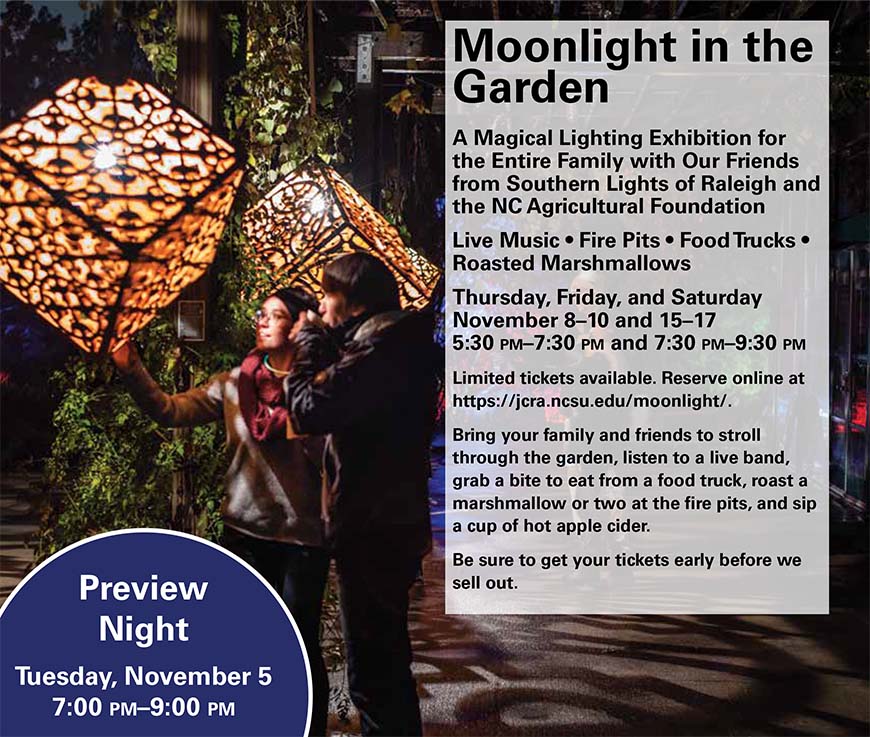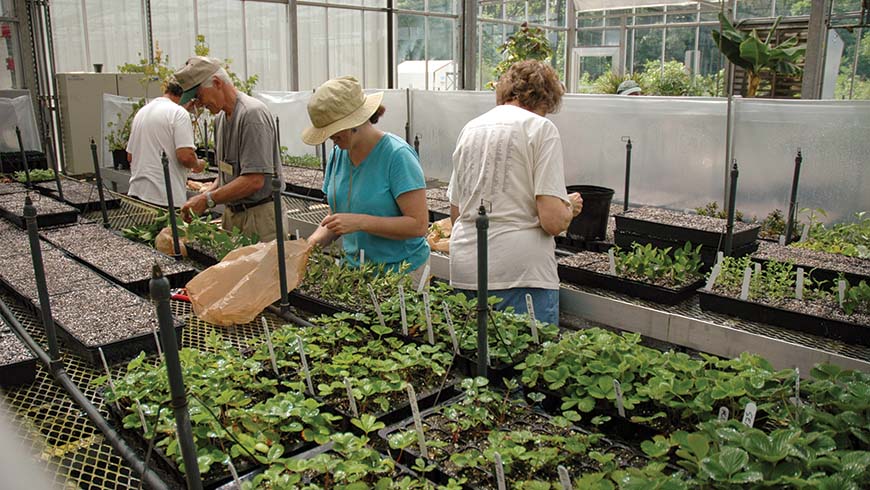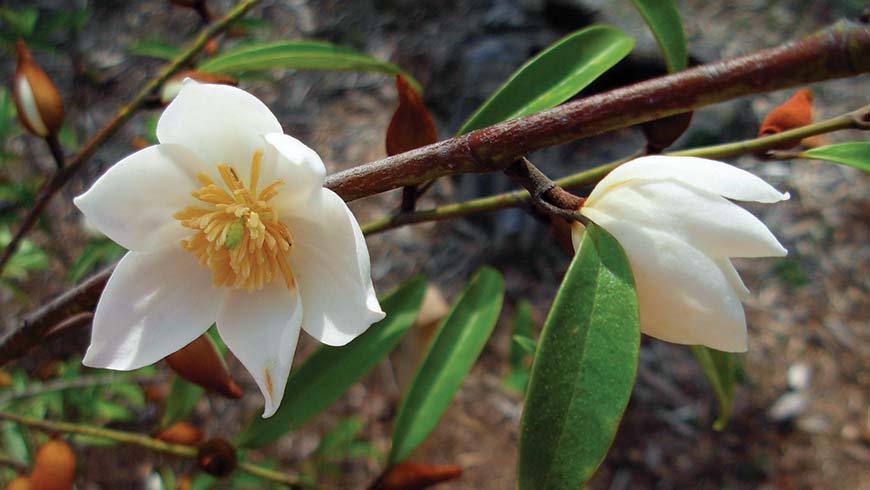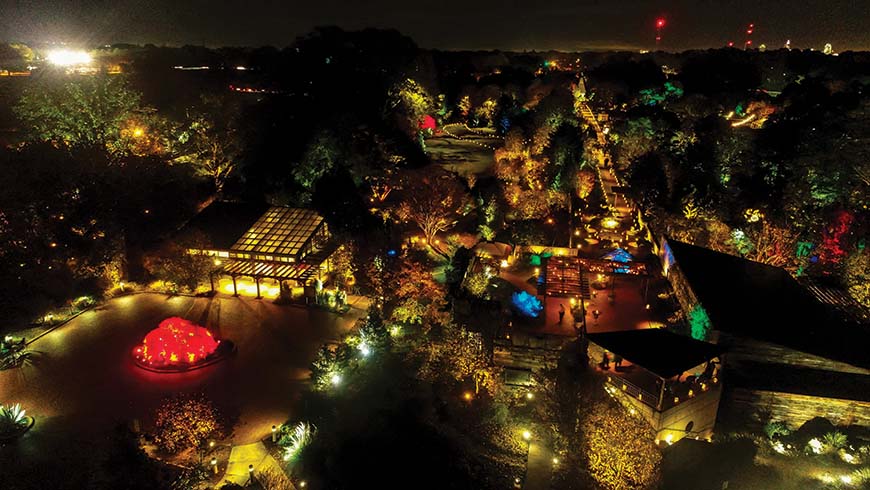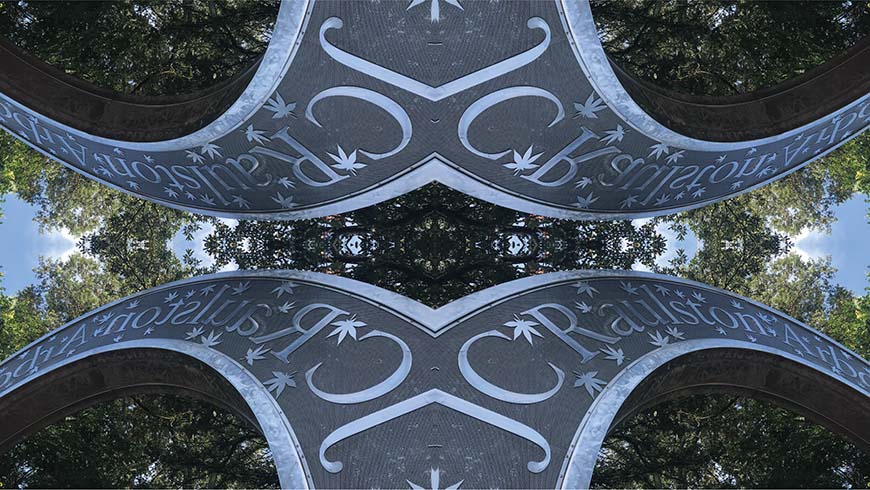Friends of the JC Raulston Arboretum Newsletter
Fall 2019 – Vol. 22, No. 2
Director's Letter
Greetings from the JC Raulston Arboretum
By Mark Weathington, Director
Time sure does fly when you're having fun! It's hard to believe I've been working here at the JC Raulston Arboretum for a dozen years. It's even more difficult when I consider that I've had the privilege to be director of this amazing organization for the past five. As I hit that five-year mark, it seems appropriate to take a look back at what we've accomplished over that time and to look forward to where we're going.

First and foremost, we've made some great strides in the garden including a brand new Finley-Nottingham Rose Garden (above), crevice garden (header), miniature conifer garden, green wall vine support on the Bobby G. Wilder Visitor Center, replanting of the Elizabeth Lawrence Border, installing a flowering lawn, and lots more. Along with the grounds, there have been some significant structural upgrades, including an overhaul of the much-used York Auditorium, a new pedestrian entry gate, and a yurt for the Children's Program.
Speaking of educational programming, in 2014 we served a total of about 1,600 youth in all of our programs while this year we had over 2,500 just for school tours alone. Adult education hasn't been left behind, either. We've evolved our offerings to provide more in-depth classes and hands-on workshops to satisfy the needs and desires of our members. Between all of our programs both adult and child, we offer nearly a program a day! One of my proudest achievements is the development of a free education series aimed at new gardeners and new-to-the-South gardeners. For those who can't come to us and learn, we wrote Gardening in the South, The Complete Homeowner's Guide to pass on our knowledge, and we post most of our lectures and tours online.
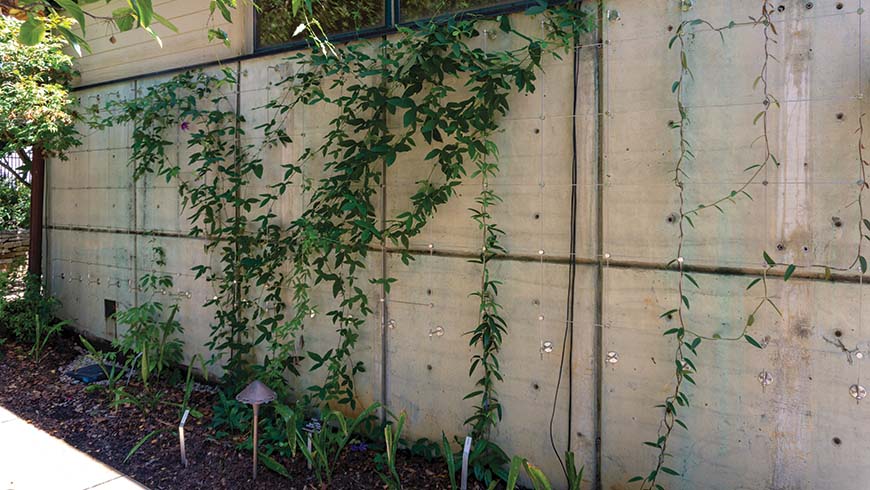
We've had other opportunities to share the Arboretum and our mission through events, travel, and other methods. Moonlight in the Garden with Southern Lights of Raleigh became the JCRA's biggest single event in 2018, its 3rd year in its current format, reaching over 6,000 people in six straight sellout nights. We helped take the Arboretum to the people with a fantastic exhibit about J. C. Raulston in the D.H. Hill Library on the NC State University campus and partnered with other campus entities like the Gregg Museum to create a cultural passport. Travel was always a passion for J. C. and so, with Earthbound Expeditions, we've developed an international travel series. To date, we've visited gardens in Cuba, South Africa, England, New Zealand, Italy, and France with Ecuador and the Galapagos Islands this winter.
Of course, the JCRA is all about the plants and we can't forget them. Over the past five years we've made collecting, speaking, and plant buying trips to China (4), South Korea, Taiwan, Japan, and the United Kingdom (2), working with colleagues from Atlanta Botanical Gardens, University of Georgia, Moore Farms Botanic Garden, the Bartlett Arboretum, Chenshan Botanic Garden, the Chinese Academy of Sciences, and the Taiwan Forestry Research Institute. We have named and released several plants over the past five years and now with former director Denny Werner back on board as JCRA plant breeder, we've just released a couple of new redbuds ('Golden Falls' and 'Flamethrower') with some exciting breakthrough selections on the horizon.

So where do we go from here and what's in store for the next five years? The recently announced merger with Juniper Level Botanic Garden will certainly continue to grow in importance. This summer saw the first joint Southeastern Plant Symposium by our two organizations—a tremendous success. Expect to see even more collaboration as we move forward. We also have plans to install more accessible pathways and to renovate, rethink, and redesign areas along Beryl Road and the east end of the Arboretum. We are in the process of adding brick columns from the pedestrian entrance to our parking lot entrance and hope to complete the entire Beryl Road span within a few years. On the plant front, plans are underway to hire a plant-breeding faculty member to work through the JCRA to increase our efforts on that front, beyond the amazing redbud work of Denny's.
Along with a new plant breeder, our amazing growth in all areas has stretched our staff to the limit and we will be adding some new staff over the coming years to help us meet all of our needs. All of these accomplishments are thanks to the incredible team we have here at the JCRA, from the superbly talented and dedicated staff to the hard-working volunteers as well as the members, sponsors, and donors who provide the means to achieve our goals.
Thank you all for your support, and I look forward to the next five years of growth.
Horticulture
Behind the Scenes
By Douglas Ruhren, Gardens Manager
The JC Raulston Arboretum at NC State University functions as a public garden if for no other reason than because it is open to the public. You might be familiar with every square inch of the Arboretum. Indeed, it seems that some visitors know every square inch in excruciating detail. Labels on newly planted tiny seedlings of tiny plants will often be pulled out and left on the ground by someone who misses no detail no matter how small, noticing the towering 1" tall rock garden plant.
Yet no matter how well one knows the public side of the JCRA, there is much that goes on behind the scenes in an area not open to the public.The JC Raulston Arboretum is 10 acres of the 42 acres of the Horticultural Field Laboratory.

Most of the JCRA's involvement with the HFL is the use of growing spaces which include:
- 3 40'×20' heated poly houses
- 2 50'×15' unheated poly houses
- 1 30'×60' "shade" house, largely used just in the frost-free months
- 1 40'×40' room in the heated glass greenhouse range.
It is in these nursery areas that seeds are started and plants are propagated by every method of asexual propagation (except for tissue culture) including cuttings, division, and grafting. Seeds and propagules come from the Arboretum, from JCRA director Mark Weathington's collecting trips in China, and other locations, from other public gardens, horticultural professionals, and commercial sources. Many public gardens produce an Index Seminum, which is a Latinized way of saying "seed list." Therefore, seed arrives from around the world.
Often, new acquisitions arrive as plants, complete plants, with roots and shoots. Occasionally they are planted in the Arboretum even before the ink has dried on the accession forms where their record in the JCRA database begins. But most often, for any number of reasons, they spend some time in the nursery before they get planted out. They might be too small to plant. Or it might be best to hold them for planting in spring rather than fall if their hardiness is unknown.
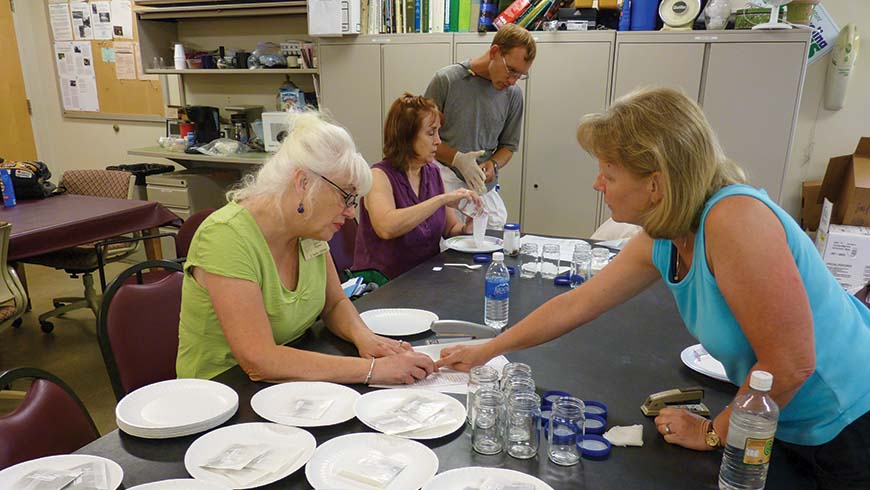
The most important reason for acquiring new plants is to get them planted in the ground in the Arboretum to evaluate their suitability to the local growing condition and worthiness of planting in gardens and landscapes. Yet the greatest amount of time and material spent in the nursery is for the various JCRA plant distributions. The largest of these is the Friends of the Arboretum Annual Plant Distribution each October when at least four thousand plants disappear in 10 minutes of this precisely choreographed, and safe, event.
The plant cart at the Bobby G. Wilder Visitor Center is kept stocked year-round and the number of plants sold over the course of the year might be close to the number that disappear in ten minutes of the plant giveaway. There are also two Connoisseur Plant giveaways each year, one for donors and one for volunteers.
The plant sale that happens during Raulston Blooms! each April consists of both plants donated by quite a few angel nurseries as well as plants raised here at the Arboretum. There is a great opportunity to increase sales by having more plants to sell, so producing more was a focus for staff this summer. Then there is the Members-only Pre-order Plant Sale. Historically, most were choice selections sourced from other growers but in the future, more will be JCRA-grown as the JCRA staff focuses on propagating the best of not-so-readily available plants in the Arboretum.
There are many hands that accomplish all this work. Like so much at the JCRA, volunteers do a huge amount of work and we thank them. Plant breeder extraordinaire Denny Werner, Ph.D., allows his technician, Leanne Kenealy, to assist with the nursery work whenever he can spare her time. Summer blesses us with four interns and they occasionally help in the nursery. The rest of the year, it's Tim Alderton and me.
And I must thank two gentlemen who support the JCRA staff in so many ways. They are Bradley Holland, the Horticultural Field Lab superintendent, and his assistant, Tim Ketchie.
This critical work of researching and understanding the new plants brought to the Arboretum is so important in helping us achieve our mission of promoting diverse plants for both the environmental and educational benefit of our community. In the nursery, we spend time learning so that we can understand how to preserve and care for these special plants—plants that may be endangered or otherwise lost entirely—with the ultimate goal of sharing them with you to brighten your homes, your gardens, and your lives. Please consider supporting this work by supporting the JC Raulston Arboretum. You can learn more about giving to funds that will help continue this work through our Web site at https://jcra.ncsu.edu/support/giving/ or by contacting our director of development, Alycia Thornton at (919) 513-7068 or alycia_thornton@ncsu.edu.
This isn't all that happens behind the scenes, but perhaps you can forgive us when it's clear that we haven't yet found the very last weed in the Arboretum plantings, now that you know that we might be hard at work in the JCRA nursery areas.
Turf War
By Mark Weathington, Director
What is our national obsession with lawns? Most people spend more time mowing, edging, blowing, watering, spraying, and fertilizing their grass than they do on almost any other household chore. All of that work just to have to do it all again next week. Now, if you have kids playing soccer on the lawn or you're into competitive bocce bowling, it makes perfect sense to have a lawn, but if the only time you step on the turf is to mow, blow, edge, etc., you might want to think about reducing the amount of turf you have and consider an alternative.
We've been experimenting with one such alternative, a flowering lawn. Unlike a meadow, plants in the flowering lawn grow to only 4"–6" tall. The idea is that you get the low cover of a traditional turf lawn, but you also have a variety of flowering plants which knit together to form a tapestry of texture and color. This tapestry is not only visually arresting, but also provides food sources for a diversity of pollinators and habitat for some of the smaller garden residents.
We began to establish our trial flowering lawn on the west side of the Ruby C. McSwain Education Center below the parking lot where we had some pretty sad turf. In order to minimize weeds, we used several successive sprays to kill off the existing turf before tilling the soil and allowing for more weed seeds to germinate. We took our time spraying off these weeds as well before planting in October.
Since there is little good information on what plants would perform best under these conditions, especially in our area, we looked for plants which would require little to no supplemental summer irrigation once established, would spread to form weed-suppressing mats, and would tolerate light foot traffic in full sun. Some easy candidates are those which are already sold as ground covers like Ajuga and Delosperma. Others included thymes, violas, and phlox. We finished off by adding a wide variety of smaller bulbs including a diversity of crocus (hopefully the squirrels left a few) and diminutive daffodils.
While it is still too early to assess the long-term suitability of many of the plants in the lawn, in less than a year, the plants have formed a beautiful tapestry and are on their way to completely covering the ground. Best of all, the occasional weeding takes less time than maintaining a pristine, jade green lawn.
At the JCRA, we love that we have the opportunity to complete unique experiments and research trials, like the flowering lawn, in order to bring creative solutions to our community of gardeners and horticulturists. Thank you for helping us continue to do so through your enthusiasm and support!
Please, Sir, Can I Have Some More?
By Cheryl Kearns, Volunteer and Board Member
Among other programs offered at the JC Raulston Arboretum, the propagation classes and workshops are some of the most popular, filling almost immediately with a waiting list promptly started. They're a wonderful way to learn not only techniques for producing more plants, but also for understanding the science behind the art of making new plants. And it's magical and fulfilling to watch a small new plant evolve into a more mature plant you can show friends and claim proudly, "I propagated (or name the method) that!" The programs are also planned so that those with any level of experience are welcome to participate.
Ever-popular classes and workshops are those that involve propagation: taking cuttings, making divisions or planting seed, for example. Participants can target just about any plant in the Arboretum, and can achieve a greater variety in their gardens while acquiring the knowledge and skill to try growing new plants later on. It enables gardeners to later share plants from their own gardens with a high degree of success.
Workshops are scheduled to accommodate both hardwood and softwood cuttings; timing is crucial to success in propagating woodies, as it is with doing a number of types of propagations. Those who have visited a grower's nursery and seen row upon row of small plants with a couple leaves just above the soil line can't help but be impressed with the number and variety of cuttings from softwood or hardwood cuttings.
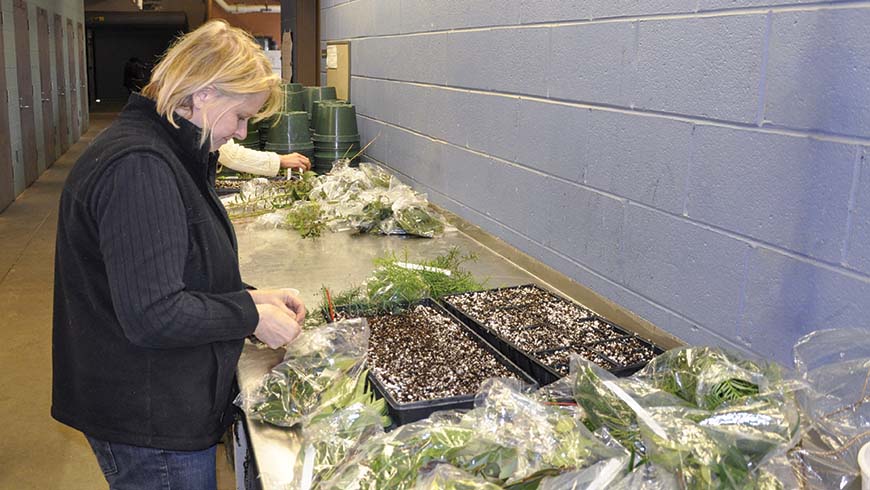
In another opportunity, the "Mr. Maple" brothers, Tim and Matt Nichols, offer their experiences in grafting Japanese maples, a special skill that involves a working knowledge of cellular activity and a steady hand in making precise cuts and blending living tissues from both the cut plant (scion) and the rootstock so that they blend to form a whole new plant. Grafting takes patience and careful hand-eye coordination, but is so rewarding.
Making divisions or knowing when and how to plant seeds of woody plants is fun and offers another option for producing new plants. Classes at the JCRA also teach those skills as well as applying those methods to perennials.
The Arboretum has also offered instruction in propagating a particularly interesting and unusual herbaceous perennial: ferns. Those little brown dots on the backs of ferns are not a disease or weird looking bug; they are its "seeds," known as spores. Working with them also involves a special skill and knowledge.
If you are interested in learning how to make new plants for yourself, keep an eye on the Web site at https://jcra.ncsu.edu/events/calendar/ for future dates. It might be that new options may also be offered focusing on grafting conifers and on a wider variety of seed propagation. Don't delay in signing up to get a spot for an exciting new adventure!
Mystery Magnolias
By Mark Weathington, Director
The 2019 annual yearbook for the United Kingdom's Royal Horticultural Society Rhododendron, Camellia, and Magnolia group features an article about the JCRA's nationally accredited Magnolia collection. While writing that overview, I became intrigued with some of our rarer magnolias and delved a bit deeper into them. Since I was limited in space for the yearbook article, here is a bit more information about these intriguing species.
We originally received Magnolia amabilis (header) as the tongue twistingly named Magnolia angustioblonga from Akira Shibamichi in the fall of 2011. At first blush, the plant looked much as described in the Flora of China (as Michelia angustioblonga) with 4" by 1", narrow, deep green leaves and coppery brown, fuzzy buds. While preparing the article for the RHS yearbook, I took a closer look at the plant and realized that the stipule scars, an extremely important identification feature for evergreen magnolias, on the leaf petioles were about half the length of the petiole. Unfortunately, true M. angustioblonga, is conspicuously missing any stipular scars.
Whenever a magnolia mystery crops up, we reach out to one of the world's foremost experts on magnolias who just happens to live in the Carolinas, albeit the wrong one. Dick Figlar quickly responded:
"In Fall of 2015 I received this plant from Tom [Ranney] labelled (same as you) as M. angustioblonga, which it obviously wasn't! Tom had received the taxon via Brian Upchurch and now I know, thanks to you, that he obtained it from Shibamichi. From the beginning it certainly resembled Sima Yong-Kang's sp. nov.(2006), so I quickly assembled some detailed photos of leaves, stipule scar etc. and sent them on to Sima who confirmed it. He further urged me to check the tepals of the flowers when it blooms, that the tepals should be conspicuously pointed at the tips instead of more less obtuse/rounded to weakly acute or emarginate as in M. laevifolia. Shortly after planting it out in March 2016 the apexes of the tepals confirmed to be acuminate. [Sima] fails to mention the most important character for distinguishing M. amabilis from M. laevifolia, which are the 50% long stipular scar on the petiole (as you have aptly observed as well).
Only other character worth mentioning is the fruits are green when ripe/at dehiscence in M. amabilis, while fruits are colored reddish/yellowish in M. laevifolia when ripe… Note: Flora of China (2008) has M. laevifolia stipular scar at 2/3 to 100% of the petiole while Chen & Noot. (1993) say M. laevifolia (as Mich. yunnanensis) stipule scar is "nearly the whole length" of the petiole."
Dick noted that his plant had received some damage during the winter, but our M. amabilis suffered no damage during the 200 consecutive hours below freezing which we experienced. The plant is much like a narrow-leafed M. laevifolia and many authorities do place it within that taxon. At any rate, it is forming a lovely shrubby plant which we hope will flower soon for us.
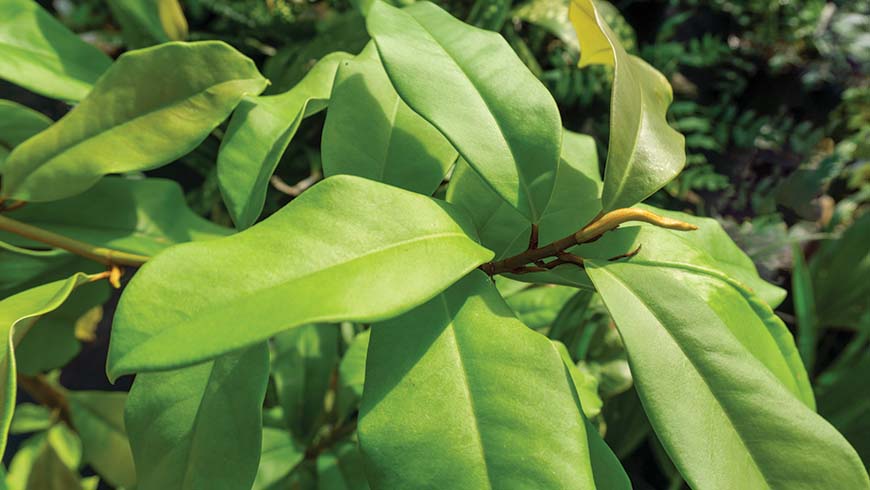
Another mystery magnolia came to us from Dick Figlar himself via Tom Ranney. This Magnolia xinganensis (above) was a new species to me and so of course I reached out to Dick for more information about where this plant came from. Dick had actually purchased the plant from Camellia Forest Nursery in 2006. Most nurseries who were selling M. fordiana actually had a similar species (M. yuyuanensis) with much narrower leaves than true M. fordiana. When Dick saw a plant with the broader leaves, he very happily bought the plant. His now, somewhat cold-tender, 30' tree finally flowered in 2017.
As Dick noted, "When the flower buds opened I knew right away this was not M. fordiana. With those unique tepals marked by horizontal striations on the abaxial surfaces, this was a rare species from Guangxi Province, Magnolia xinganensis (syn. Manglietia oblonga)."
The incredibly thick textured petals are cracked and striated like fine Chinese porcelain. The species was originally collected in the 1980s from Xing'an in Guangxi Province by researchers at the South China Botanic Garden. The plant can ultimately grow to over 50' tall and typically has golden yellow hairs on the buds and bottom surfaces of the leaves.
Magnolia flowers shift between a female receptive phase when the stigma will accept pollen and a phase when the pollen sheds from the anthers. This behavior ensures plenty of cross pollination as beetles move pollen from flower to flower looking for the nectar produced when the stigma is receptive. Dick writes that, "the flower opens into the female phase later in the evening than any other species that I have observed, including M. delavayi," and that the flowers open nearly a month after both the true M. fordiana and M. yuyuanensis. Apparently, Dick spent a sizable portion of the evening well up on a ladder in the name of science to observe the flowering closely and make some hand pollinated crosses.
Cliff Parks originally collected seed of this magnolia back in 1993 near Yuyuan in Guangdong Province in south China. The original collection of M. xinganensis by the South China Botanic Garden was close by in Guangxi Province, not 80 miles away. Gardens, like the JCRA and South China Botanic Garden along with experts such as Dick Figlar and specialty nurseries which keep accurate records of plant acquisitions, are critical for learning more about the world's flora and preserving plants both in and outside of their native ranges.
The JCRA will be collecting in the very same region where M. xinganensis is found in October of 2019 with colleagues from China as well as the Atlanta Botanic Garden and the University of Georgia. These plant-collecting expeditions are not intended to just fill the grounds at the JCRA but also to progress the field of horticulture and help the Arboretum achieve its important mission of conservation and collaborative research. Through these trips, we are able to study and document, distribute plants to like-minded institutions, and save endangered plants through ex situ conservation. These trips are vital to the mission of the Arboretum and can only be undertaken with the help and support of our members who give to our plant collecting special fund. If you are interested in supporting plant exploration and research, please visit https://jcra.ncsu.edu/support/giving/ for more information on how to do so.
Arboretum Updates
Hottest Ticket in Town
By Arlene Calhoun, Assistant Director
From the best kept secret to the hottest ticket in town, Moonlight in the Garden has put the JC Raulston Arboretum on the list of things to do in Raleigh! You know the best kept secret is out when you're on the WRAL home page and people are searching Nextdoor for tickets and willing to pay above ticket value. Imagine our excitement when every night sold out.
We're gearing up for another Moonlight season and are reminded of how far this event has come. Each year, historical records are broken. Event goals were set in 2016 and we haven't looked back. Who am I fooling? This event has exceeded so many expectations we can't stop looking.
In 2016, our objectives were clear: create a nighttime fall event that was on mission and which kept the collections safe. Goals were further defined as: Introduce new audience; fund-raiser, membership driver, new garden experience for those who knew us. Our revenue goal that first year was to break even. The event budget was $15,000. We were cautious. This was our first multi-night, multi-weekend event. How to staff? How would the garden fare with that many guests at once? What if it rained?
The event came and went, and we couldn't stop smiling for months. We were open for five nights, sold 1,303 advance tickets; welcomed 2,655 guests; utilized 135 volunteers (77 new) and sold 24 memberships. Our gross revenue was $42,646 and our event expenses were under budget at $14,391. Our staff and volunteers were exhausted, but we were thrilled that all who visited were very respectful of the gardens and were delighted to have discovered the best kept secret in Raleigh!
For comparison Moonlight in the Garden 2018 was open for six nights, sold 6,313 advance tickets, welcomed 6,917 guests; utilized 116 volunteers (95 volunteers worked more than one night) and sold 122 memberships. We grossed $145,000 and our event expenses were $51,730. As you can imagine, the phones are already ringing with people asking when this year's tickets will be going on sale (September 3 for Arboretum members). Most calls are coming from people who are not members of the garden. I think we can safely say, the secret is out!
We wouldn't have gotten this event off the ground without the tireless help and talents of John Garner and his team at Southern Lights of Raleigh. In 2016, they donated the lighting design, fixtures, and labor to install it. We love working with this amazing team who respect and understand the importance of the Arboretum.
John Garner is as passionate about landscape lighting design as we are about plants! It's been a great partnership. Each year, he changes the design and somehow manages to sneak in another area of the garden enlarging the exhibit. We have a very dedicated group of volunteers who have joined John and his team with the installation efforts. I wish we knew how many miles of cable Rob Thornton, Kerry MacPherson, Dave White, Tom Dickey, Jim Pendergast, Jim Schlitt, Andrew Clarke, and Jeanette Lee have installed, uninstalled, measured, and documented. These dedicated JCRA volunteers are an integral part of getting this massive lighting exhibit installed.
A big shout out to our community sponsors, Simchock Stone, and the many folks who keep the Arboretum and Moonlight in the Garden as a part of their conversations. It is this tremendous network that has put this event over the moon.
Mark your calendars! Preview Night is, Tuesday, November 5.
Students Bring Energy
By Kathryn Wall, Membership and Volunteer Coordinator
Arboretum members tell me all the time they don't know how so much is accomplished by such a small staff, especially when we are experiencing so much growth. Our staff is full of highly talented and skilled people who enjoy working together. And part of that achievement is due to amazing volunteers who provide expertise and manpower, which in 2018 was equivalent to six full-time employees.
We've also been able to leverage another valuable asset: students. Through NC State University's Provost Professional Experience Program (PEP) which provides partial funding, we've employed up to seven student workers. The JCRA has a long history of involving horticulture and agriculture education students in the summer months, but through PEP, we've had students in those areas through the academic year. For the last four academic years, PEP has expanded our student help into marketing and communications, geographic information software, children and adult education programs, and membership and volunteer coordination.
It's been a great partnership. Staff and volunteers enjoy working with students who have fresh energy and bring a new perspective. There's nothing quite as eye-opening as having a 20-year-old read your marketing copy and not understanding the "inside joke" or reference you made. They use their ease and expertise with software and technology to perform tasks efficiently, and teach us new techniques.
Many times the skills students bring are not easily found in volunteers. Sam Davis, our GIS student, assisted in the mapping in the JCRA plantings and helped design the public facing Web maps. All private tour scheduling this spring was handled by Holly Keepers, the membership and volunteer assistant. She also set up all online volunteer signups through SignUpGenius, and created posters and flyers for Arboretum events.
The education goes both ways. Arboretum staff look to involve students with project-based experiences they can use in their job search ahead. For the first NC State University Day of Giving last March, Allyson Meade, our marketing and communication student, created the kaleidoscope image of our gate shown above. She also wrote posts for all our social media, and monitored the social media streams for questions, comments, and tagging of the Arboretum in images. Haleigh Swenfurth, the adult education student, wrote fresh copy for programs on our Web site, developed local contacts for the annual Birdhouse Competition, created a database of public garden staff to help promote our first Southeastern Plant Symposium, and made phone calls to verify class enrollment.
Based on our positive experience, this summer we had a student intern, Hannah Wall, from Enloe High School Academy of Graphics and Advertising to help with signage and special projects. This fall, we will welcome new students in five PEP positions, and are expanding into two work-study positions.
We are so grateful to be a part of a number of programs that bring tremendous skill and talent to the JCRA team. We hope to continue expanding our ability to offer (and benefit from!) such opportunities through our own student internship program. Please consider supporting this initiative to help us continue bringing bright and eager young minds to the JCRA. You can do so by visiting https://jcra.ncsu.edu/support/giving/student-internship-program/.
